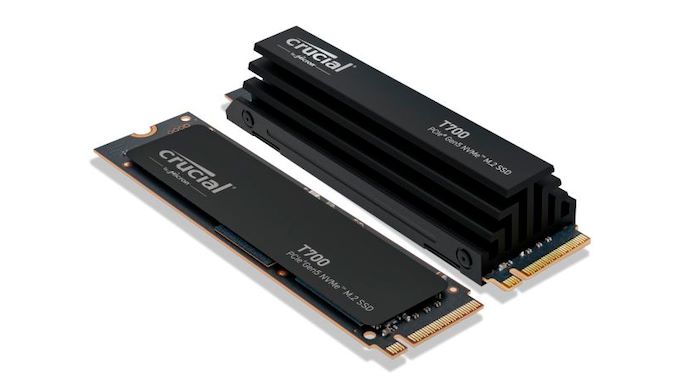Crucial has started to tease the T700, the company's first mainstream PCIe 5.0 SSD. Not to be confused with the Terminator T-700, the T700's product page has already gone live but still lacks some of the M.2 2280 SSD's finer details. However, it does show some basic specifications that suggest that the T700 will deliver higher performance than rival first-generation PCIe 5.0 drives.
Different as they may look, the first wave of SSDs all have something in common: they leverage Phison's PS5026-E26 PCIe 5.0 controller and its eight-channel design. There are other PCIe 5.0 SSD controllers for storage vendors to pick from, including Silicon Motion's SM2508 or InnoGrit's IG5666. However, the E26 has become the de facto PCIe 5.0 controller for PCIe 5.0 SSDs.
The T700, like many rivals before it, utilizes the E26 controller. Crucial rates the T700 with sequential read and writes up to 12.4 GB/s and 11.8 GB/s, respectively. It's twice as fast as the P5 Plus PCIe 4.0 SSD and up to 22 times faster than the MX500 SATA SSD. Crucial has granted Linus Tech Tips a small preview of the T700. An extract from the previewer's guide has exposed the T700's sequential and random performance. According to the snippet, the expected sequential read and write performance on the T700 is 12 GB/s and 11 GB/s. The figures are somewhat lower than the specifications from the T700's product page. The T700's numbers reach 1.5 million IOPS reads and writes regarding random performance. The performance varies slightly between the different capacities.
If the T700 delivers on the claims, it would make the drive one of the fastest PCIe 5.0 SSDs and put it ahead of its competitors, such as the Corsair MP700, Gigabyte Aorus Gen5 1000, or the MSI Spatium M570 Pro. The only faster drives in development are Adata's Project Nighthawk and Project Blackbird SSDs, with sequential read and write speeds of 14 GB/s and 12 GB/s and 14 GB/s and 10 GB/s, respectively. Adata's forthcoming PCIe 5.0 SSDs are the only confirmed drives to employ the Innogrit IG5666 PCIe 5.0 controller.
| Crucial T700 Specifications | |||
| 1 TB | 2 TB | 4 TB | |
| Seq Reads (MB/s) | 11,500 | 12,000 | 12,000 |
| Seq Writes (MB/s) | 8,500 | 11,000 | 11,000 |
| Random Reads (K IOPS) | 1,200 | 1,500 | 1,500 |
| Random Writes (K IOPS) | 1,500 | 1,500 | 1,500 |
| Endurance (TBW) | 600 | 1,200 | 2,400 |
The E26 controller can deliver sequential read and write speeds up to 14 GB/s and 11.8 GB/s, respectively, if paired with 2,400 MT/s NAND. Unfortunately, current PCIe 5.0 SSDs are far from exploiting the E26's full potential due to the limited supplies of that newest-generation NAND. Many drives sport 1,600 MT/s NAND, so they fail to break the 10 GB/s barrier. Like its competitors, the Crucial T700 uses Micron 232-layer 3D TLC NAND chips. Micron's 232-layer NAND runs at different speeds: 1,600 MT/s, 2,000 MT/s, and 2,400 MT/s. Crucial didn't specify the grade of the NAND with the T700, but given the SSD's advertised performance, it stands to reason that the drive likely uses the 2,000 MT/s variant. There are obvious perks to Micron being the parent company. Crucial likely has dibs on the higher-binned NAND chips, so securing 2,000 MT/s NAND isn't as big of an issue. Surprisingly, Crucial didn't equip the T700 with 2,400 MT/s, but that could be a cost-benefit decision, or 2,400 MT/s NAND yields haven't reached the point where there's a steady supply.
Crucial offers the T700 in 1 TB, 2 TB, and 4 TB capacities. The 4 TB model has the best endurance at 2,400 TBW. The T700 is available with and without a heatsink, so the drive will fit into desktops, laptops, and gaming consoles. Linus Tech Tips' results showed the maximum operating temperatures between the T700 with the included heatsink (67 degrees Celsius) and the T700 with the motherboard heatsink (66 degrees Celsius) were similar after 15 minutes of stressing the SSD at 100% disk usage. However, there weren't any tests with the non-heatsink version. Many PCIe 5.0 SSDs come with beefy passive heatsinks, and some even have a tiny cooling fan for active cooling. On the T700's product page, Crucial recommends that consumers install the non-heatsink version on a motherboard or an alternate heatsink to ensure the best performance.
Crucial still needs to reveal the pricing for the T700. However, the company tweeted that the T700 will be available in May, so it's a short wait before we get more details on the PCIe 5.0 drive.
from AnandTech https://ift.tt/mvNQ6jE
via IFTTT

0 comments:
Post a Comment